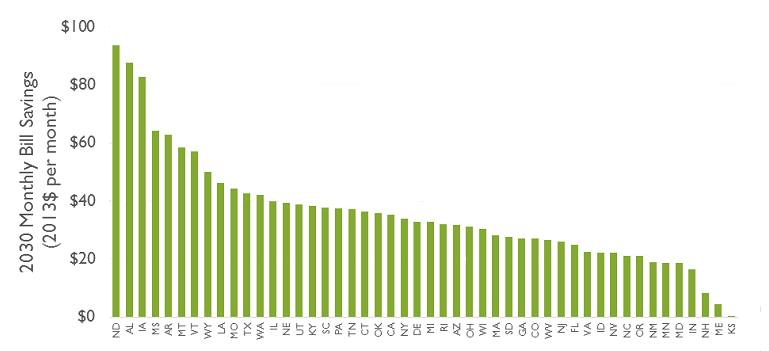How Clean Power Will Save Us Money in the Long Run
Register here for tomorrow's webinar on this analysis
In a series of recent briefs on the consumer costs of low-emissions futures, Synapse demonstrates that a Clean Energy Future scenario that exceeds the emissions targets of EPA’s Clean Power Plan can also lower electricity bills nationwide. The idea that investing heavily in clean energy and energy efficiency programs will save households money may be surprising to some, but in the third and final brief in the series, released today, Synapse discusses the logic behind why this is the case and why—if it’s so appealing—states haven’t already embarked on similar trajectories.
Synapse’s Clean Energy Future scenario (described in detail in this background report) saves households with strong participation in energy efficiency programs $35 per month on electricity bills in the year 2030 as compared to a business-as-usual scenario. Clean energy and energy efficiency are becoming more cost effective than fossil fuel generation for a variety of reasons, including declining operational costs and avoiding costly retrofits to comply with environmental regulations other than the Clean Power Plan.
Figure 1. Clean Energy Future bill impacts by state

Critics might think: Sure, renewables are cost-effective once they are hooked up to the grid. But what about the costs of integration? As discussed in the brief, recent Synapse reports have shown that not only are barriers to harnessing more renewable energy beginning to break down, but the costs of overcoming these barriers to integrate large amounts of wind and solar are minimal.
The brief also addresses the critique that such a favorable outcome—a total of $40 billion saved by consumers nationwide in 2030—must mean that the modeling assumptions ignore the full range of potential costs to consumers. In fact, Synapse modeled the high end of the range of potential costs. For example, the authors explain that the cost assumptions include 100 percent of the impact of investments made in fossil fuel plants that will be retired before the end of their economic life (in reality, these “stranded costs” may or may not be passed on to ratepayers). Moreover, the analysis does not include monetized climate and health benefits of clean energy, which would add further value to the Clean Energy Future scenario.
Synapse is hosting a webinar tomorrow, September 3, at 2 PM EST to discuss the analysis and how the Clean Energy Future remains a win-win given the final targets in the Clean Power Plan. To register for the event, visit http://bit.ly/1Ew2E8e.